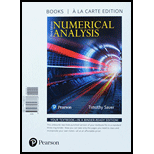
Numerical Analysis, Books A La Carte Edition (3rd Edition)
3rd Edition
ISBN: 9780134697338
Author: Timothy Sauer
Publisher: PEARSON
expand_more
expand_more
format_list_bulleted
Concept explainers
Textbook Question
Chapter 10.3, Problem 1SA
Run the code to form the filtered signal yf, and use MATLAB’s sound command to compare the input and output signals.
Expert Solution & Answer
Want to see the full answer?
Check out a sample textbook solution
Students have asked these similar questions
3. A different 7-Eleven has a bank of slurpee fountain heads. Their available flavors are as follows: Mountain
Dew, Mountain Dew Code Red, Grape, Pepsi and Mountain Dew Livewire. You fill five different cups full
with each type of flavor. How many different ways can you arrange the cups in a line if exactly two Mountain
Dew flavors are next to each other?
3.2.1
Business
What is the area of this figure?
5 mm
4 mm
3 mm
square millimeters
11 mm
Submit
8 mm
Work it out
9 mm
Chapter 10 Solutions
Numerical Analysis, Books A La Carte Edition (3rd Edition)
Ch. 10.1 - Prob. 1ECh. 10.1 - Find the DFT of the following vectors: (a) [...Ch. 10.1 - Prob. 3ECh. 10.1 - Prob. 4ECh. 10.1 - Prob. 5ECh. 10.1 - Prob. 6ECh. 10.1 - Prob. 7ECh. 10.1 - Prob. 8ECh. 10.2 - Use the DFT and Corollary 10.8 to find the...Ch. 10.2 - Prob. 2E
Ch. 10.2 - Prob. 3ECh. 10.2 - Prob. 4ECh. 10.2 - Find a version of (10.19) for the interpolating...Ch. 10.2 - Find the order 8 trigonometric interpolating...Ch. 10.2 - Find the order 8 trigonometric interpolating...Ch. 10.2 - Prob. 3CPCh. 10.2 - Prob. 4CPCh. 10.2 - Prob. 5CPCh. 10.2 - Prob. 6CPCh. 10.3 - Prob. 1ECh. 10.3 - Prob. 2ECh. 10.3 - Find the best order 4 least squares approximation...Ch. 10.3 - Prob. 4ECh. 10.3 - Prob. 5ECh. 10.3 - Prob. 1CPCh. 10.3 - Prob. 2CPCh. 10.3 - Plot the least squares trigonometric approximation...Ch. 10.3 - Prob. 4CPCh. 10.3 - Gather 24 consecutive hourly temperature readings...Ch. 10.3 - Run the code to form the filtered signal yf, and...Ch. 10.3 - Compute the mean squared error (MSE) of the input...Ch. 10.3 - Prob. 3SACh. 10.3 - Prob. 4SACh. 10.3 - Design a fair comparison of the Wiener filter with...Ch. 10.3 - Download a .wav file of your choice, add noise,...
Knowledge Booster
Learn more about
Need a deep-dive on the concept behind this application? Look no further. Learn more about this topic, subject and related others by exploring similar questions and additional content below.Similar questions
- No chatgpt pls will upvotearrow_forwardFind all solutions of the polynomial congruence x²+4x+1 = 0 (mod 143). (The solutions of the congruence x² + 4x+1=0 (mod 11) are x = 3,4 (mod 11) and the solutions of the congruence x² +4x+1 = 0 (mod 13) are x = 2,7 (mod 13).)arrow_forwardhttps://www.hawkeslearning.com/Statistics/dbs2/datasets.htmlarrow_forward
- Determine whether each function is an injection and determine whether each is a surjection.The notation Z_(n) refers to the set {0,1,2,...,n-1}. For example, Z_(4)={0,1,2,3}. f: Z_(6) -> Z_(6) defined by f(x)=x^(2)+4(mod6). g: Z_(5) -> Z_(5) defined by g(x)=x^(2)-11(mod5). h: Z*Z -> Z defined by h(x,y)=x+2y. j: R-{3} -> R defined by j(x)=(4x)/(x-3).arrow_forwardDetermine whether each function is an injection and determine whether each is a surjection.arrow_forwardLet A = {a, b, c, d}, B = {a,b,c}, and C = {s, t, u,v}. Draw an arrow diagram of a function for each of the following descriptions. If no such function exists, briefly explain why. (a) A function f : AC whose range is the set C. (b) A function g: BC whose range is the set C. (c) A function g: BC that is injective. (d) A function j : A → C that is not bijective.arrow_forward
- Let f:R->R be defined by f(x)=x^(3)+5.(a) Determine if f is injective. why?(b) Determine if f is surjective. why?(c) Based upon (a) and (b), is f bijective? why?arrow_forwardLet f:R->R be defined by f(x)=x^(3)+5.(a) Determine if f is injective.(b) Determine if f is surjective. (c) Based upon (a) and (b), is f bijective?arrow_forwardPlease as many detarrow_forward
arrow_back_ios
SEE MORE QUESTIONS
arrow_forward_ios
Recommended textbooks for you
- Algebra & Trigonometry with Analytic GeometryAlgebraISBN:9781133382119Author:SwokowskiPublisher:Cengage
 Glencoe Algebra 1, Student Edition, 9780079039897...AlgebraISBN:9780079039897Author:CarterPublisher:McGraw Hill
Glencoe Algebra 1, Student Edition, 9780079039897...AlgebraISBN:9780079039897Author:CarterPublisher:McGraw Hill Holt Mcdougal Larson Pre-algebra: Student Edition...AlgebraISBN:9780547587776Author:HOLT MCDOUGALPublisher:HOLT MCDOUGAL
Holt Mcdougal Larson Pre-algebra: Student Edition...AlgebraISBN:9780547587776Author:HOLT MCDOUGALPublisher:HOLT MCDOUGAL

Algebra & Trigonometry with Analytic Geometry
Algebra
ISBN:9781133382119
Author:Swokowski
Publisher:Cengage

Glencoe Algebra 1, Student Edition, 9780079039897...
Algebra
ISBN:9780079039897
Author:Carter
Publisher:McGraw Hill

Holt Mcdougal Larson Pre-algebra: Student Edition...
Algebra
ISBN:9780547587776
Author:HOLT MCDOUGAL
Publisher:HOLT MCDOUGAL
Sequences and Series Introduction; Author: Mario's Math Tutoring;https://www.youtube.com/watch?v=m5Yn4BdpOV0;License: Standard YouTube License, CC-BY
Introduction to sequences; Author: Dr. Trefor Bazett;https://www.youtube.com/watch?v=VG9ft4_dK24;License: Standard YouTube License, CC-BY